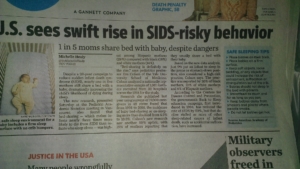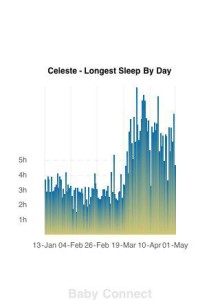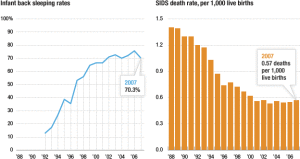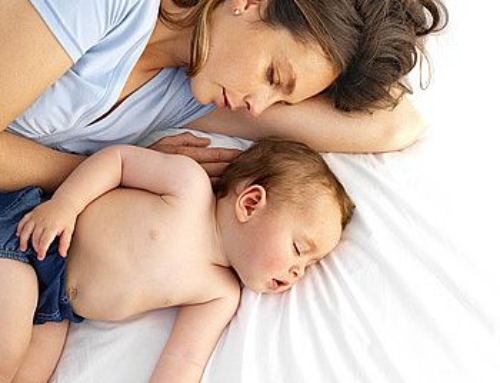In an article this weekend in USA Today (see photo below), one Ms. Michelle Healy reports on new data suggesting that despite the 20-year campaign to end SIDS, nearly 20% of mothers now report bedsharing on a regular basis. According to her, this “dramatically increases the child’s likelihood of dying during sleep”. Although no citations are provided for this rather sweeping statement, it clearly comes from the recent Carpenter et al study
So first, let’s talk about this risk: Is it real? As I have written about time and again, no. The real risk is unsafe bedsharing. The data used by Carpenter and colleagues not only didn’t include all known risk factors, the way in which the data was collected at times (i.e., the questions asked) were vague enough that it’s unclear what they mean. For example, alcohol consumption, duvet use, whether or not a baby’s head was covered, illegal drug use, and more were all variables that were not recorded by all the centres in the meta-analysis. Those that collected information on alcohol consumption focused on drinks in the last 24 hours, not those taken with time to influence impairment before bed. Then you add to this that the control group was not all babies, as most people assume, but rather all female babies. Why? Because the rate of SIDS for boys is 60% more likely (or 50% when the other variables are considered). Finally, for the missing data, they imputed it using a sophisticated technique; however, the assumption of this technique was that the data has to be similarly distributed across the different cases. That is, something like rates of alcohol use must be the same in order to impute, but this assumption doesn’t hold when looking cross-country, especially with some of the countries and areas included herein.
In addition to the rather mess that is the Carpenter et al study, we have data from Alaska[2] in which the death of all bedsharing SIDS and suffocation cases were examined on a case-by-case basis. Their finding? Only 1 case in 13 years had zero risk factors. 99% of cases had at least one risk factor, over 60% of cases had more than 2. Then there is other research suggesting a non-significant odds-ratio for bedsharing when bedsharing is intentional, but significant increases in risk when it is unplanned[3]. Thus the issue of how dramatically dangerous bedsharing is has been blown way out of proportion and in fact, isn’t supported by what we know from recent studies that are taking care to include more and more variables of interest.
This brings us to this new research mentioned herein that suggests bedsharing is on the rise[4]. Notably, back in 1993 regular bedsharing was reported by only 6.5% of households. By 2010, this number had risen to 13.5%. In the last 4 years, it has increased again to 19%. Importantly, these are only the people that report regularly bedsharing, not those who do it on occasion because it’s easiest in the moment and for whom no safety precautions are likely taken. This raises some very important issues that caregivers and educators should take note of. First, despite massive campaigns in the last few years to discourage bedsharing, it is on the rise. This is likely due in part to its role in facilitating breastfeeding[5], but also because of its ability to let mom get some more sleep. In a country where women are expected back at work at 6 weeks postpartum, physically getting up at night to feed your baby is something that can result in extreme exhaustion. Sleeping with your baby allows one to feed while still resting. A friend of a friend shared this graph of her sleep. She had used an app to track her longest sleep by day. Take a look at guess at when she switched over to bedsharing…
Has this increase in bedsharing been linked to greater SIDS rates? Interestingly, no. Despite a 3x increase since 1993, rates for SIDS seem to still be predominantly linked to having babies sleeping in the prone position. This is likely due to the fact that the families answering this survey are speaking about intentional bedsharing. They are the families making an intentional decision and likely making sure it is an educated decision. Interestingly, some suggest that the rates of SIDS have stalled due to the increase of other behaviours, like bedsharing. However, there is no evidence I can find that suggests as much, though I don’t discount that unintentional and unsafe bedsharing contribute to deaths unnecessarily. Considering the fact that we are seeing that in some states the rates of putting a baby to sleep on his/her back is as low as 50%, with the most vulnerable infants – premature babies – having some of the lowest rates of prone positioning[6], and we have to wonder, is bedsharing really at fault? Indeed, is setting up an “ideal” of sleep possible without considering the needs and situation of each individual family?
What needs to be discussed here is what is needed with respect to safe infant sleep education and bedsharing. The standard response the last few years has been to just keep telling parents it’s wrong and to stop it. Yet we now know that’s not working in terms of maternal behaviour, and in fact research from the UK suggests it may even put more babies at risk as parents engage in even riskier behaviours like sofa-sharing or falling asleep in rocking chairs[7]. What we are learning through recent studies is that bedsharing per se is not inherently a risk factor (though we should have been able to know this from looking at Japan alone as it has one of the highest rates of bedsharing and one of the lowest SIDS rates). What is risky is engaging in this practice without taking the necessary precautions or being aware of the factors that increase the risk of accidental suffocation.
Perhaps it’s time for a call to change the agenda. Change the way we speak about bedsharing. Instead of fear mongering, why not focus on educating families about how to bedshare safely if they are going to do it? We need to speak about the risks of not being prepared to take your baby into bed with you, but deciding to do it because you’re just too tired to do anything but. We need to educate families about having an alternative (like side-cribbing or an arms reach co-sleeper) for the nights when it may be safer to do that instead of bedshare, like when mom is sick and taking cold medication. In short, we need to educate parents about the real risks with respect to bedsharing, especially unintentional bedsharing which I am certain makes up even more than 20% of the population, and about the benefits it offers families, why they choose it, and how to choose it safely. We have to stop demonizing a practice which can be safe and is incredibly instinctual and natural for many parents. When we stop focusing on education and instead focus on spreading fear, we force parents to lie about it, to hide it, and most importantly, to do it unsafely. In that situation, nobody wins.
For more information on how to bedshare safely, you can download this safe bedsharing pamphlet or read an article here.
For more information on bedsharing and SIDS, you can read this.
For a wonderful book on safe co-sleeping, please check out this one from Dr. James McKenna.
____________________________
[1] Carpenter RG, McGarvey C, Mitchell EA, Tappin DM, Vennemann MM, et al. Bed sharing when parents do not smoke: is there a risk of SIDS? An individual level analysis of five major case-control studies. BMJ Open 2013; 3: e002299.[7] Blair PS. Perspectives on bed-sharing. Current Pediatrics Reviews 2010; 6: 67-70.









Perhaps you could contact USA Today and ask them to run a piece looking at the other side of the story – perhaps something fact-based? You could give them some articles and some experts to contact i.e. James McKenna…?
Excellent article Tracey, thank you
For 100’s of thousands of years humans and their ancestors slept with their babies. As far as I know all mammals sleep with their babies.
If pillows and blankets cause problems, throw them out of the bed, not the baby- who’s every instinct tells it, safety is with its mother.
Then, when a baby dies unexpectedly, lets consider that perhaps, as sad as it is, it’s genes were just not cutout to continue.
While the idea of keeping every child alive is noble, it ignores evolution, and creates impossible expectations on parents and society.
I remember how much happier my daughter was when we moved my pillow out of our bed and her in. (she was a few months old, 21 years ago, and I read that every time she got a cold I would need to retrain her to sleep on her own-but everybody can get used to any sleeping arrangement-I figured fine then i will get used to sleeping with her-funny thing was all those bad-dreams i kept having of my child being missing went away too).
Also-I’ve often wondered what would happen to those “bad” co-sleeping statistics if they added in car accidents, and work accidents from overtired parents to the side of the separate sleeping arrangements.
Excellent point about the risks of sleep deprivation!!!!
[…] Bed-sharing on the rise. Everyone panics. […]